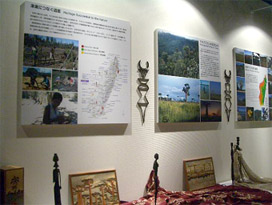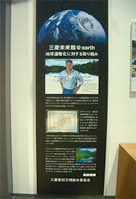Cooperation in reducing greenhouse gas emissions
- Mitsubishi Pavilion @Earth and Madagascar -
On February 16, 2005, the Kyoto Protocol came into effect. The Kyoto Protocol is an international agreement to reduce emissions of greenhouse gases, including CO2, which is considered to be the chief culprit in global-warming. Under the Protocol, Japan is obliged to cut its greenhouse gas emissions by 6% from the 1990 level between 2008 and 2012. However, in 2003, such emissions in Japan increased by as much as 8% from the 1990 level; Japan thus has to reduce 14% in real terms, to fulfill its pledge in the Kyoto Protocol. The predominant view is that Japan will not be able to achieve the reduction target of 14% through its own countermeasures alone.

Exhibits of Madagascar at Africa Pavilion, Global Common 5
The Kyoto Protocol introduced three mechanisms, called “Kyoto Mechanisms,” as flexible instruments to make it easier, through cooperation with other countries, for industrialized countries to meet greenhouse gas emission reduction targets that are difficult to fulfill through the nations' efforts alone. One such mechanism is the Clean Development Mechanism (CDM). The CDM is designed to allow advanced countries to earn credit toward meeting their emissions reduction targets by partnering with a developing country in a project to reduce greenhouse gas emissions in the developing country.

At the Mitsubishi Pavilion @Earth, an initiative is under way based on the CDM concept stated in the Kyoto Protocol. In an effort to offset CO2 and other greenhouse gas emissions produced during construction of the Pavilion and during the Exhibition period, Mitsubishi Group has provided financial support to help protect tropical rain forests in northern Madagascar. This initiative will offset Mitsubishi's carbon impacts by preventing the release of carbon dioxide (CO2) into the atmosphere through the protection of a portion of Makira's threatened forests, which naturally store carbon, thereby preserving species of animals and plants in the region, and by supporting sustainable activities of local communities there.
Greenhouse gases have been released everywhere in the richness of human life, and have steadily accumulated in the atmosphere. We hope that CDM and other similar initiatives, in which advanced and developing countries work together to address global warming problems, will continue to increase so as to further aid in curbing global warming.


